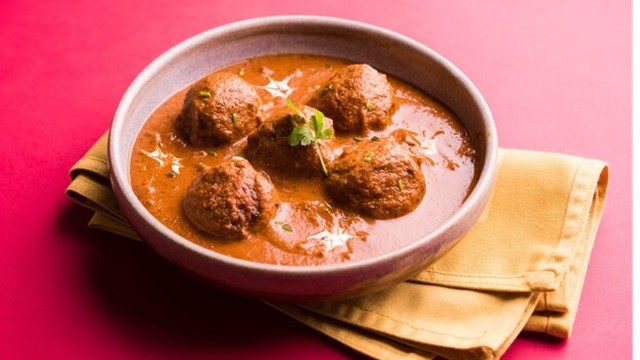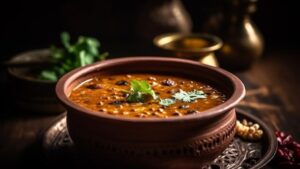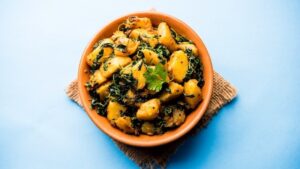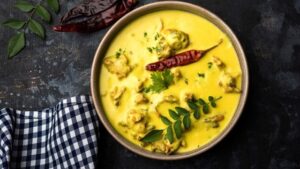Introduction.….
Malai Kofta, a jewel in the crown of Indian cuisine, stands as a testimony to the country’s culinary opulence. A dish revered for its richness, complexity of flavors, and velvety textures, it holds a cherished place in the hearts and palates of food enthusiasts worldwide. Embarking on an exploration of Malai Kofta promises a delightful journey into the realms of history, cultural significance, and gastronomic delight.
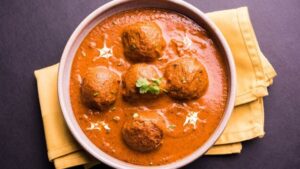
Historical Roots: The Royal Origins of Malai Kofta
Malai Kofta traces its lineage back to the regal courts of the Mughal Empire, an era renowned for its opulence, artistic endeavors, and culinary sophistication. The dish emerged as a masterpiece crafted by royal chefs, seeking to elevate the dining experience of the Mughal emperors and their courts.
Mughal Culinary Opulence:
During the reign of the Mughal dynasty in India (16th to 19th centuries), culinary excellence was highly prized and celebrated. The Mughals, known for their refined tastes and love for extravagant feasts, patronized the development of intricate, flavorful dishes that reflected their sophistication and cultural diversity.
Birth of Malai Kofta:
Malai Kofta, born in this atmosphere of culinary extravagance, became a manifestation of culinary finesse. Its name, “Malai” signifying cream and “Kofta” referring to the flavorful dumplings, encapsulated the essence of richness and indulgence sought after in Mughal gastronomy.
Evolution of Culinary Craftsmanship:
The creation of Malai Kofta wasn’t merely about sustenance; it was an art form. Royal chefs meticulously crafted a dish that combined creamy textures, fragrant spices, and a harmonious blend of ingredients to satisfy not just hunger but also the refined tastes of the Mughal royalty.
Legacy and Enduring Appeal:
With its origins steeped in royal refinement, Malai Kofta transcended the confines of the imperial court, finding its way into the hearts and kitchens of people across regions. Its legacy persists, evolving and adapting to different culinary traditions while retaining the essence of its regal origins.
Cultural Significance:
Malai Kofta, a dish once reserved for royal banquets, became a symbol of celebration and festivity. Its presence at significant events, from grand festivities to intimate gatherings, symbolized the warmth of hospitality and the sharing of joyous moments.
Intrinsically linked to the Mughal era, Malai Kofta stands as a culinary masterpiece that continues to enchant with its rich historical heritage, carrying forward the legacy of a bygone era of culinary opulence into the modern
Mastering Malai Kofta: Expert Tips and Tricks
Vegetable Preparation:
- Consistency is Key: Ensure vegetables are boiled to the right tenderness. Overcooked vegetables can make the koftas mushy, while undercooked ones may affect the texture.
- Proper Mashing: Mash the boiled vegetables thoroughly, aiming for a smooth yet slightly coarse texture to maintain a pleasant mouthfeel in the koftas.
Binding the Koftas:
- Balancing Ingredients: Use a balance of grated paneer (Indian cottage cheese) and binding agents like corn flour or all-purpose flour. This ensures the koftas hold their shape without becoming too dense.
- Chill the Mixture: Refrigerate the shaped kofta balls for 15-20 minutes before frying. This helps them retain shape and prevents disintegration while frying.
Frying Techniques:
- Optimal Oil Temperature: Heat the oil to medium-high. Too low, and the koftas might soak up excess oil; too high, and they might brown too quickly without cooking inside.
- Even Frying: Fry the koftas in batches, ensuring there’s enough space between them for even cooking and browning.
Gravy Mastery:
- Balancing Creaminess: Blend cashews well to create a smooth paste for the gravy. This imparts creaminess without overwhelming the dish.
- Layering Flavors: Cook the onion-tomato paste until it releases oil, allowing the spices to bloom and infuse into the gravy. This step enhances the depth of flavor.
Serving and Presentation:
- Garnish Artfully: Use fresh coriander leaves or a sprinkle of kasuri methi (dried fenugreek leaves) for a burst of color and added aroma.
- Serve Hot: Malai Kofta is best enjoyed piping hot, allowing the flavors to meld together deliciously.
Adaptation and Experimentation:
- Personalize the Recipe: Feel free to experiment with spices, adding your twist to suit your taste preferences without compromising the essence of the dish.
- Healthier Options: Explore alternative ingredients or cooking methods to make a healthier version, like baking the koftas instead of deep-frying.
Applying these expert tips and techniques will elevate your Malai Kofta preparation, ensuring a delightful dish that retains its authenticity while allowing for personal touches and innovation.
. Malai Kofta Recipe: A Sumptuous Indian Delight
Ingredients:
For Kofta:
- 2 cups mixed boiled vegetables (potatoes, carrots, peas, beans)
- 1/2 cup paneer (Indian cottage cheese), grated
- 3 tablespoons corn flour or all-purpose flour
- 1/2 teaspoon garam masala
- 1/2 teaspoon red chili powder
- Salt to taste
- Oil for frying
For Gravy:
- 1 cup onion-tomato paste (made by blending onions and tomatoes)
- 1 tablespoon ginger-garlic paste
- 1/2 cup cashew nuts, soaked and blended into a smooth paste
- 1 cup fresh cream (malai)
- 1 teaspoon red chili powder
- 1 teaspoon coriander powder
- 1/2 teaspoon turmeric powder
- 1/2 teaspoon garam masala
- 1/2 teaspoon kasuri methi (dried fenugreek leaves)
- Salt to taste
- 2 tablespoons oil
- Fresh coriander leaves for garnish
Instructions:
Making Kofta:
- Begin by boiling a mix of vegetables such as potatoes, carrots, peas, and beans until they are soft. Once done, drain the water and let them cool.
- Mash the boiled vegetables in a large mixing bowl until they form a smooth texture without any lumps.
- Add grated paneer, corn flour or all-purpose flour, garam masala, red chili powder, and salt to the mashed vegetables. Mix everything thoroughly to create a dough-like consistency that holds together well.
- Divide the mixture into equal portions and shape them into round or oval-shaped balls (koftas). Ensure they are compact enough to hold their shape during frying.
- Heat oil in a deep pan over medium heat. Once the oil is hot, gently slide the koftas into the oil, ensuring not to overcrowd the pan. Fry them in batches until they turn golden brown and crispy on all sides. Once done, remove the koftas and place them on absorbent paper to remove excess oil. Set aside.
Preparing Gravy:
- In a separate pan, heat 2 tablespoons of oil over medium heat.
- Add ginger-garlic paste to the hot oil and sauté until the raw aroma dissipates and the mixture turns golden brown.
- Pour in the onion-tomato paste and cook until it thickens and the oil starts to separate from the sides. This process might take around 8-10 minutes.
- Lower the heat and add red chili powder, coriander powder, turmeric powder, garam masala, and salt. Mix well and allow the spices to cook for a couple of minutes until fragrant.
- Add the smooth cashew paste to the spice mixture. Stir continuously to combine and avoid any lumps from forming.
- Pour in fresh cream (malai) and gently mix until the gravy becomes creamy and well-incorporated. Let it simmer on low heat for a few minutes.
- Crush kasuri methi (dried fenugreek leaves) between your palms and add it to the gravy. Stir well and let it simmer for an additional 2-3 minutes. Adjust the consistency of the gravy by adding water if required. Taste and adjust seasoning as per your preference.
Assembling:
- Place the fried koftas in a serving dish just before serving.
- Pour the hot and creamy gravy generously over the koftas, ensuring they are well coated.
- Garnish with a sprinkle of fresh coriander leaves to add a burst of freshness and color to the dish.
Malai Kofta is now ready to be served! It pairs excellently with naan, roti, or steamed rice. Enjoy the creamy, flavorful goodness of this classic Indian dish with your loved ones.
This recipe can be tailored according to your taste preferences, so feel free to adjust the spice levels or experiment with additional ingredients to make it your own.
You can further enhance this detailed recipe by explaining the importance of certain steps, offering tips to ensure the koftas retain their shape while frying, or suggesting serving ideas and side dishes that complement Malai Kofta perfectly.

